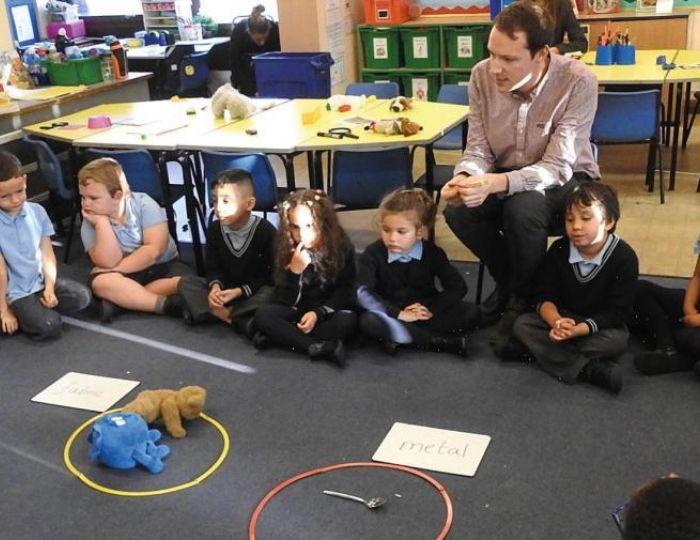When I worked for Shropshire County Council’s business team, much of our work focussed on skills gaps, particularly around the area of STEM. While many businesses here are concentrated around agriculture, food and tourism, we also have a tremendous number of engineering and technology businesses clustered around Telford, where our team was based.
It soon became clear that schools and businesses in the area were almost working in parallel with each other – businesses with their recruitment expectations and lack of curriculum knowledge proceeding along one line, and schools unaware of those expectations and focused on their own curriculum goals along the other. The two never seemed to meet.
Through Twitter I would regularly come across many fantastic opportunities available to schools for improving their STEM teaching in partnership with businesses, yet many of the schools we worked with seemed to have no awareness of them. What I wanted to do was bring together schools and businesses more directly, and encourage them to start having conversations with each other. If this is something you’ve previously considered doing in your own area, here’s what I would suggest.
Step 1 – Establish your contacts
Ask parents if they have any links to companies that draw on STEM skills and are finding it difficult to recruit. Are they able to open channels of communication between the school and someone senior at the company who might be interested in giving their staff the chance to become a STEM Ambassador? Try contacting the Growth Hub run by your nearest Local Enterprise Partnership. And ask to speak to a business advisor. The staff there will likely be in contact with newly established businesses that want to form links with the local community, including schools, but aren’t sure how to go about it.
By registering with the STEM Alliance, you can request visits by STEM Ambassadors who may be able to help your school with various projects and topics of work. Every registered STEM Ambassador – I’m one myself – receives a regular newsletter containing requests for assistance and invitations submitted by local schools.
It’s also worth contacting outreach staff at nearby universities and approaching STEM teachers at local secondaries, who may have already established contacts with local businesses regarding work experience placements and careers advice for school leavers. Make a point of involving your SBM in the process, since they will often attend conferences at which they’re able to gain ideas from what other SBMs are doing and sometimes establish contacts with universities and businesses themselves.
You could also consider partnering with other primary schools in your area and forming a STEM group, which may provide you with greater clout when approaching businesses for the first time.
Step 2 – Make your approach
During your initial exchange with a business, good points to raise include the potential CPD benefits of school visits for its staff, and how partnering with a school can boost its local profile – mention the phrase ‘Corporate Social Responsibility’ and people’s ears will prick up. Explain that it can lead to good exposure in the press, and suggest that if it works, you’d be open to building a long-term relationship.
Give some thought as to type of activity you envisage, and bear in mind that ‘hands on’ stuff tends to work best. Having a business simply come in and talk to pupils isn’t ideal, particularly at primary, because what your visitors say will be too far removed from the pupils’ experiences. A better idea would be to run a science- themed workshop with practical activities that your visitors can assist with.
Above all, make it as easy as possible for businesses to engage with you; don’t leave it all to them. It’s no good simply saying ‘We want you to come and run something on STEM for us,’ because they won’t know what you want. Be specific – ‘We’re having a space week.’ Work some national days and themes into your approach. Women In Engineering Day, for example, takes place on 23 June every year. That allows you to propose a specific idea to engineering businesses months ahead of time – ‘We’d love to do something themed around women in industry. Could you come along and run two workshops tailored towards girls that involve engineering?’
It helps to respect people’s time. Businesses operate from 9 to 5, whereas schools effectively operate between 10 and 3. Staff from a business could visit the school between 10 and 11, or 1.30 and 2.30 in the afternoon, so that it doesn’t eat too much into their day and still make an effective contribution over the course of an hour.
Step 3 – Think long term
All being well, the business will offer to send along one or two members staff to take part, and they’ll come away from the experience having got something out of it
– perhaps a boost to their confidence and communication skills. After each visit, get your teachers to complete feedback forms and pass them on to the business.
If both parties agree that the event was a success, try to keep things going. Consider what you’re both going to do next and get the date in the diary. If you’re able to build ongoing relationships with multiple businesses, you won’t have to keep approaching the same contacts for help, but be able instead to draw on a range of different specialisms – digital, engineering, science – when planning future activities.
In some cases it might even be possible to attract sponsorship to assist with costlier activities and equipment purchases. The price of a 3D printer will likely stretch the budget of a school, but could represent small change for a business.
Nor need partnerships such as this be strictly one-way. Some local businesses might be open to setting up embedded placements for your teachers during the school holidays, giving them a chance to see first-hand how the business world operates in terms of decision-making and communication, and pass that knowledge on to their classes.
Partnerships in action
Within the past 18 months I’ve helped to organise the following events:
STEM Day, Dawley C of E Primary Academy
A five-hour event involving 200 pupils, spanning nursery to Year 6, which was attended by representatives of Harper Adams and Birmingham City universities. Each year group partook of different activities that included a rocket car race, a 3D printing session, a code club and an ‘F1 racing car experience’, where pupils were able to try changing the wheels on a real life Formula 1 car.
STEAM Co Telford
An event held at Enginuity, part of Ironbridge Gorge Museums, that was attended by 70 pupils from seven primary schools in the local area.
Teen Tech Telford
A live event supporting the STEM education provider TeenTech. Attended by 270 Year 8 children and supported by 30 local and national organisations. Was co-sponsored by the local council and Wolverhampton University, alongside a £25k sponsorship provided by local business.
Susan Coleman is a former business advisor for Shropshire County Council










